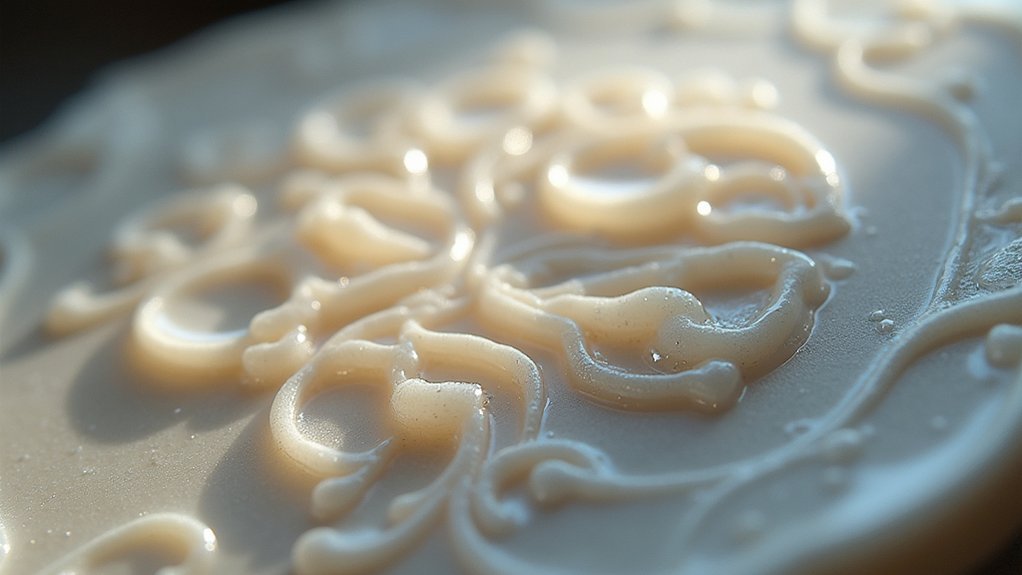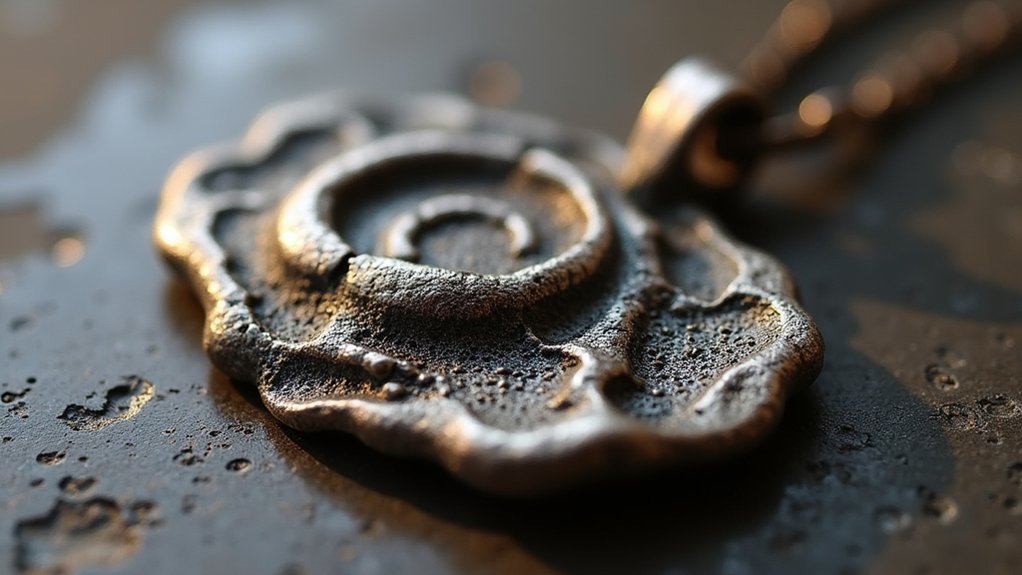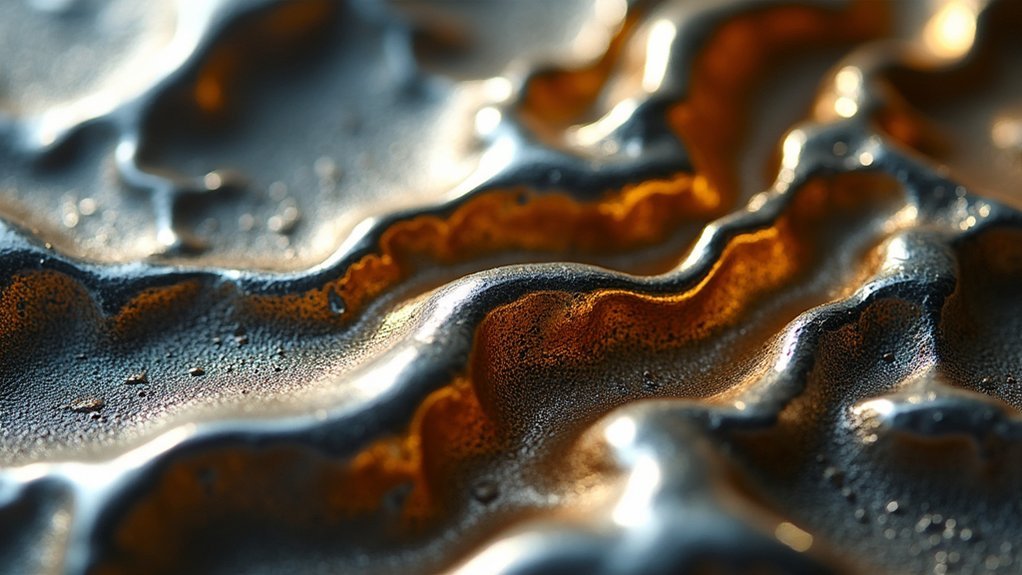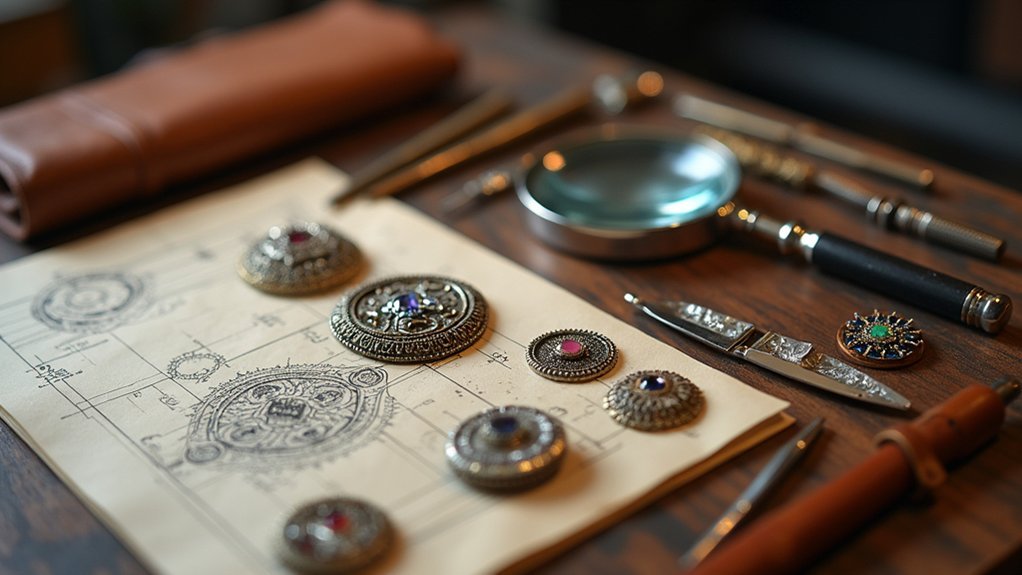You can fix the seven most common jewelry casting defects by improving your mold venting to prevent air entrainment, heating metal 150-200°F above melting point to avoid cold shuts, switching to sulfur-free fuel sources to eliminate surface discoloration, using clean metals and vacuum atmospheres to reduce porosity, ensuring seamless wax attachments in tree building, controlling burnout temperatures to prevent rough textures, and allowing proper investment hardening time before handling flasks. Master these techniques to transform your casting success rate.
Air Entrainment in Wax Patterns

When injecting wax into molds, you’ll often encounter air entrainment that creates structural weaknesses in your patterns. These trapped air bubbles form during the injection process when displaced air can’t escape properly.
You’ll notice this defect through recessed cavities or surface imperfections on your wax patterns, which directly impacts your final casting quality.
Poor mold venting is the primary culprit behind air entrainment. Your venting system must allow air to escape efficiently during injection. Additionally, using high-quality wax materials helps minimize air pocket formation.
To prevent air entrainment, guarantee your mold designs include adequate venting channels.
Regularly maintain furnace components like gaskets and hose clamps to prevent external air contamination.
Visual inspection of completed patterns helps identify these defects early, protecting your casting quality.
Cold Shuts and Flow-Related Issues
You’ll encounter cold shuts when your molten metal doesn’t fuse properly during casting, creating smooth-edged grooves that weaken your jewelry’s structure.
These defects stem from poor temperature control, inadequate metal flow patterns, and insufficient gating systems that disrupt the casting process.
Temperature Control Methods
Although cold shuts might seem like minor surface imperfections, they’re actually serious defects that occur when molten metal fails to properly fuse during casting, creating smooth-edged grooves or lines that greatly compromise your jewelry’s structural integrity.
Effective temperature control methods prevent these flow-related issues by maintaining ideal conditions throughout the investment process. You’ll need to monitor both casting temperature and metal temperature closely while making sure your flask temperature stays within proper ranges.
| Temperature Control Factor | Recommended Action |
|---|---|
| Metal Temperature | Heat 150-200°F above melting point |
| Flask Temperature | Preheat to 800-1200°F depending on metal |
| Pouring Speed | Maintain steady, controlled flow |
| Temperature Monitoring | Use pyrometer throughout process |
| Cooling Rate | Allow gradual cooling in flask |
Consistent temperature management guarantees your final product achieves maximum structural integrity and surface quality.
Metal Flow Patterns
Since molten metal behaves like a flowing river during casting, understanding its movement patterns becomes essential for preventing cold shuts and other flow-related defects that can ruin your jewelry pieces.
When you don’t maintain proper pouring temperature and time, the metal solidifies before completely filling your mold, creating those telltale smooth-edged grooves.
Your sprue system design directly impacts metal flow quality. Sharp corners and sudden directional changes create turbulence, leading to casting defects and gas entrapment that compromises surface quality.
You’ll want to design smooth, tapered connections that guide the molten metal seamlessly through your investment casting mold.
Monitor your pouring speed carefully—too fast creates turbulence, while too slow allows premature cooling.
Consistent, controlled pouring guarantees peak flow patterns throughout your casting process.
Prevention Best Practices
Preventing cold shuts and flow-related defects requires maintaining ideal temperatures throughout your casting process—both for the molten metal and the flask itself.
You’ll need to monitor your metal’s temperature carefully and guarantee your investment mold stays warm during pouring.
Design your gating system with rounded corners and adequate sprue sizes to promote smooth flow patterns.
Control your pour rate—slow, steady pouring reduces turbulence and maintains continuous flow.
Proper venting prevents gas entrapment that disrupts metal flow and creates surface defects.
The quality of the mold directly impacts your results, so inspect your investment for cracks or weaknesses.
Regular maintenance of your casting equipment identifies issues before they compromise your casting processes and final jewelry pieces.
Surface Discoloration and Black Casting
When you notice unwanted stains or dark discoloration on your cast jewelry surfaces, you’re likely dealing with one of the most frustrating defects in the casting process.
Surface discoloration and black casting typically stem from three primary causes that you can control:
- Overheating during the melting process – Excessive temperatures create oxidation and color changes.
- High sulfur content – Contamination from torch flames or fuel sources creates dark, unsightly marks.
- External contamination – Mercury or foreign materials that compromise your metal’s purity.
You can dramatically improve casting quality by implementing reducing agents in your investment material and switching to sulfur-free fuel sources.
These preventive measures minimize sulfur compound formation while protecting against contamination that leads to black casting defects.
Porosity Problems in Cast Metal

Although porosity defects rank among the most common issues you’ll encounter in jewelry casting, they’re also some of the most preventable when you understand their underlying causes.
You’ll face three main types of porosity problems: gas porosity from trapped gases during solidification, shrinkage porosity when metal flows inadequately into cooling sections, and investment porosity from defective mold materials.
Combat gas porosity by using clean metals and vacuum atmospheres during melting.
Address shrinkage porosity through optimized mold design with strategic risers that guarantee proper metal flows.
Prevent investment porosity by selecting high-quality investment materials and mixing under vacuum conditions.
Essential casting techniques include maintaining proper venting systems, controlling pour temperatures, and perfecting your pouring methods to eliminate air entrapment throughout the process.
Tree Building and Attachment Defects
When you’re building your casting tree, poor wax attachment techniques can create weak points that’ll compromise your final piece’s structural integrity.
You’ll need to master proper attachment methods to prevent protrusions from breaking off during casting, which would leave cavities that weaken your jewelry.
Learning to identify tree building flaws before casting saves you from costly defects like cold shuts and incomplete mold filling.
Proper Wax Attachment Techniques
Since proper wax attachment forms the foundation of successful jewelry casting, you’ll need to master these techniques to prevent structural defects that can compromise your final pieces.
Poor attachments create protrusions that break off during casting, leaving cavities in your final piece and reducing mechanical strength.
Follow these essential steps:
- Control Temperature and Pressure – Use adequate wax temperatures during injection to prevent air entrapment, which weakens cast structures.
- Create Seamless Joints – Guarantee smooth joining points between patterns to eliminate protrusions and defects in casting.
- Check Alignment Regularly – Inspect pattern positioning on trees to prevent misalignment that causes casting inaccuracies.
Training your staff on proper wax attachment techniques will greatly reduce casting defects and improve your jewelry’s structural integrity.
Identifying Tree Building Flaws
Because tree building errors multiply throughout the casting process, you must identify structural integrity flaws before they compromise your entire investment.
Examine attachment points closely—smooth, seamless connections indicate proper technique, while protrusions or uneven joints signal foundational problems that’ll create defects in your finished pieces.
Check your wax patterns’ positioning carefully. Central placement guarantees ideal metal flow, preventing cavities and weak spots.
Look for rough or incomplete bond areas where patterns meet sprues, as these tree building flaws directly impact casting outcomes.
Implement systematic quality control inspections at each building stage.
Train your team to recognize problematic connections early, since identifying issues before pouring saves time and materials while maintaining the mechanical strength your jewelry demands.
Wrinkled and Rough Surface Textures

Although wrinkled surfaces and rough surface textures don’t compromise your jewelry’s structural integrity, they’ll greatly influence the final piece’s aesthetic appeal.
These defects manifest as undulations and roughness typically confined to one side of your cast jewelry piece.
During the burn-out process, rapid heating creates these surface irregularities.
You’ll notice this problem when:
- Flask positioning occurs too close to furnace walls
- Uneven heating causes irregular temperature distribution
- Inadequate control over heating rates during burn-out
To prevent wrinkling, place your flasks centrally in the furnace and maintain controlled heating rates.
This guarantees uniform temperature distribution throughout the burn-out process.
While these defects won’t affect mechanical strength, you’ll need post-defect grinding and polishing to restore aesthetic quality.
Regular furnace maintenance considerably reduces these surface texture issues.
Incomplete Wax Burnout and Investment Issues
When wax residue remains trapped within your investment mold after burnout, you’ll face surface contamination that creates visible defects throughout your final casting. Incomplete wax burnout occurs when you don’t provide adequate heating cycles, leaving residual material that compromises the surface of a casting.
| Issue | Cause | Solution |
|---|---|---|
| Wax residue | Insufficient burnout time | Minimum 6-8 hours heating |
| Dewax defects | High water content in investment | Monitor mixing ratios carefully |
| Surface irregularities | Poor investment materials | Use distilled water only |
| Watermarks | Premature flask movement | Allow proper investment time |
Casting defects occur when you rush the investment process. Careful management of your investment materials prevents these problems. Always guarantee proper hardening before moving flasks, as premature handling creates lasting surface imperfections.
Frequently Asked Questions
What Are the Seven Casting Defects?
You’ll encounter seven main casting defects: air entrainment creating cavities, wrinkled surfaces from rapid heating, cold shuts from low temperatures, cracks from stress, pores from poor investment, inclusions from contamination, and shrinkage porosity.
How to Avoid Casting Defects?
You’ll prevent casting defects by implementing strict quality controls, ensuring proper mold design with adequate venting, maintaining ideal temperatures, training staff regularly, and using advanced equipment to minimize human error.
What Is the Defect in Jewelry Casting?
You’ll encounter defects like air entrainment causing structural weaknesses, surface irregularities creating wrinkled appearances, cracks from temperature issues, pores from contamination, and shrinkage porosity when metal doesn’t fill molds completely.
What Causes Pinholes in Casting?
You’ll get pinholes when trapped gas can’t escape during solidification. They’re caused by inadequate venting, moisture in molds, contaminated metal, excessive pouring temperatures, or rapid cooling that doesn’t allow gases to escape properly.
In Summary
You’ve now got the knowledge to tackle jewelry casting’s most frustrating defects. Don’t let air bubbles, cold shuts, or porosity ruin your pieces anymore. Apply proper wax handling techniques, control your temperatures, and perfect your investment procedures. Remember, consistent tree building and complete burnout cycles are essential for professional results. With these fixes in your toolkit, you’ll produce cleaner castings with superior surface finishes every time.





Leave a Reply